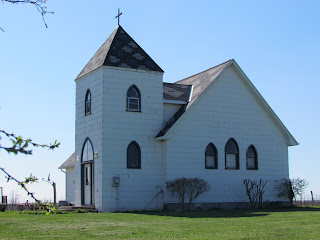 Yesterday I spent some time in Hillier township, tracking down the origins of a unique road name. I took a road never travelled, heading south from Melville toward Wellington along dusty Chase Road.
Yesterday I spent some time in Hillier township, tracking down the origins of a unique road name. I took a road never travelled, heading south from Melville toward Wellington along dusty Chase Road.
I had just entered the wide expanse of vineyards belonging to a winery named for the roads that intersect nearby (Closson and Chase roads) when this beautiful little church came into view. What an outstanding display of the roofer's art, emulating the multicoloured slate roofs of its big city brethren.
I suspect that the former church (I didn't find any signage as to its denomination) may now be providing refuge for seasonal workers. I did notice a number of smallish cottages round about which in my lifetime on farms used to be called 'tenant houses.'
Now my scripture knowledge is a bit rusty, but it seems to me there is a nice resonance between gentle fields of newly greening grapevines and an historic little church whose parishioners did their best to create something splendid. I'll leave that for you to contemplate.
 |
| Brockville - big city polychrome slate |
PS Mystery solved. I've remembered a book in my history library, a 1971 Christmas gift to our grandparents from our mom and dad. History of the Churches of Prince Edward County. It has interesting origins. Compiled by the Picton Branch of the PEC Women's Institutes, it is one of those fine local histories titled Tweedsmuir books. I'll leave you to look up their origin. This compilation was revised and edited by Patricia Taylor and published by the Picton Gazette Publishing Company.
The little church is (was) Christ Church, Hillier, an Anglican church. Seems to me that Anglican churches can always be counted on to be, well, churchier. More picturesque. Even this humble example in the countryside. Christ Church was begun in 1846, destroyed by lightning in 1944, and rebuilt by 1947. Things found, things missing. The photo in the book shows the stones of the churchyard to the southeast of the entrance. But the fuzzy photo doesn't reveal those inspiring patterned shingles.


No comments:
Post a Comment